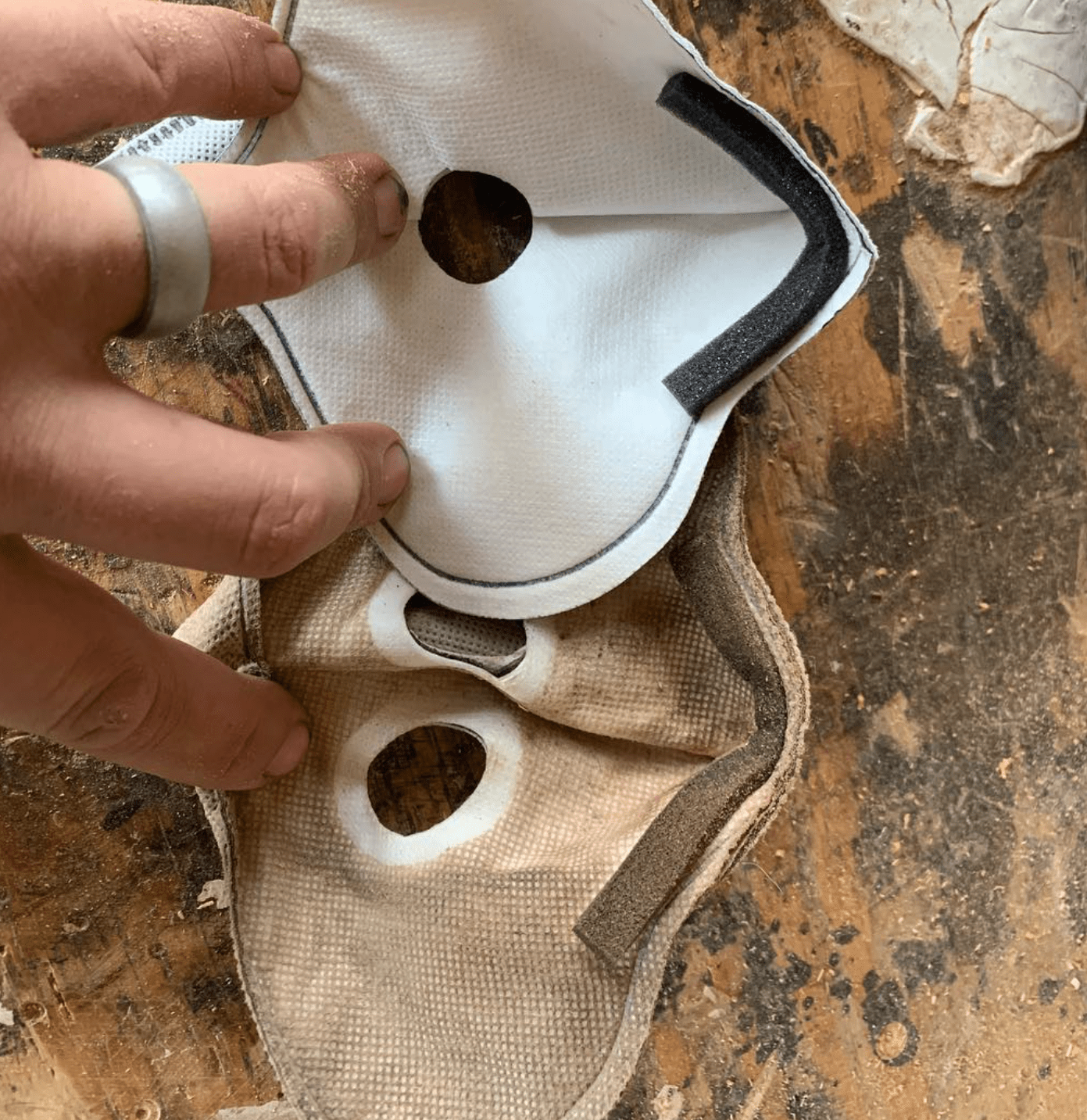It’s not just Earth Day that calls on us to make thoughtful, sustainable decisions, but every day. As woodworkers and DIYers, you may have asked yourself how you can be more environmentally sustainable in your woodworking. We’ve compiled six tips for sustainable woodworking practices to consider for your next project.
1. CHOOSE SUSTAINABLE PPE  As a woodworker, you know that dust is dangerous to your lungs and that you need the proper PPE to keep yourself safe. In addition to being safe, you can also choose more eco-friendly PPE. BILLIONS of masks land in the ocean and landfills every year according to a survey out of the University of Denmark, particularly with increase of mask use during the COVID-19 pandemic. Choosing a reusable dust mask like the RZ Mask is more comfortable and allows you to replace just the inside filter, saving frequent mask wearers over $500 a year on average and saving over 200 disposable masks from landing in a landfill.*
As a woodworker, you know that dust is dangerous to your lungs and that you need the proper PPE to keep yourself safe. In addition to being safe, you can also choose more eco-friendly PPE. BILLIONS of masks land in the ocean and landfills every year according to a survey out of the University of Denmark, particularly with increase of mask use during the COVID-19 pandemic. Choosing a reusable dust mask like the RZ Mask is more comfortable and allows you to replace just the inside filter, saving frequent mask wearers over $500 a year on average and saving over 200 disposable masks from landing in a landfill.*
*Based on daily, high filtration disposable mask wear 50 weeks/year

2. TOOL SHARING
Don’t have the tools needed to finish your latest project? Instead of wasting time, gas and money on a trip to the store to buy the tools, consider borrowing or renting them instead. Ask your neighbor, friends or family to borrow tools you may not have or reach more people by posting on social media or to local community pages. If you can’t find someone to borrow from, most hardware stores offer tool rental programs. Whether you borrow or rent, when you pool your tools you save money, create relationships within the community, and help the environment since fewer resources are used.
3. BUY SUSTAINABLE OR RECLAIMED WOOD

It’s important to select wood that is either sustainable, reclaimed, or locally-sourced.
Sustainable wood is timber that has been harvested responsibly from well managed forests that fight deforestation by planting seedlings faster than trees are being cut down. Curious if you’re using sustainable wood for your project? Just look for the FSC (Forest Stewardship Council) certification logo. This logo guarantees that wood is sourced from responsibly managed forests.
Here are some sustainable woods you can use for your next project:- Bamboo
- White Ash
- Oak
- Mahogany
- Maple
- Black Cherry
- Pine
- Douglas Fir
Reclaimed wood is another great option to continue the life cycle of the wood and keep it out of the burn pile. You can typically find reclaimed wood in old barns, mill buildings, shipping crates, old buildings, salvage and lumber yards, and used furniture, to name a few!
Locally-sourced wood means that it has come from a forest in your region to a local sawmill and then to a local distributor. Locally-sourced lumber has a lower carbon footprint since it hasn’t had to travel long distances by freight to reach its final destination.
4. Give wood scraps a second life Before you let scrap wood pile up or worse, throw it away, make a plan to use all of your wood to avoid waste and be environmentally responsible. Not only is it an eco-friendly woodworking practice, some of the most creative projects start from a challenge like this!
Before you let scrap wood pile up or worse, throw it away, make a plan to use all of your wood to avoid waste and be environmentally responsible. Not only is it an eco-friendly woodworking practice, some of the most creative projects start from a challenge like this!
Need some ideas for your scrap wood? Here are a few to get your started:
- Sell or give away through local sites like craigslist and Facebook marketplace.
- Donate it to a school that might be able to use it in their wood shop.
- Create small woodworking items like coasters, shelving, cutting boards and more. Check out more ideas from Family Handyman!
- If you have kids, let them use it to make a fort.
- If you have a chipper, consider turning it into sawdust.
5. DISPOSE OF PAINT & CHEMICALS RESPONSIBLY 
Paint can be toxic and dangerous to the environment if it’s not disposed of properly. If you are unable to donate or find another use for leftover paint, it’s important to be aware of local laws, as different counties or states may have specific laws regarding legal disposal procedures. Here are a couple steps to help you dispose of latex and oil-based paint you no longer need.
Latex Paint
Latex paint can be discarded by most waste collection companies as long as the paint inside of the can is dried out and solid. To speed up the drying process, add cat litter or shredded newspaper to the paint, stir, and let it air dry inside the can. Throw the can and its dried contents into the garbage for regular pickup. You can also purchase a paint hardener, which can be found at many home improvement stores.
Oil-Based Paint
Oil-based paint is considered hazardous and must be taken to an appropriate hazardous waste disposal or drop-off center. Unsure of where to drop-off your leftover paint? Do a quick internet search for some local disposal or drop-off sites in your area.
 Furniture flipping has become extremely popular in recent years and for good reason! Not only is furniture flipping eco-friendly, but it’s economical too! To get started and to find items to salvage, visit local charity shops or garage sales. Then comes the fun part: up-cycling and adding an individual touch to your new piece. Take a look at a few of our favorite recent furniture flip projects by these DIY Furniture Flipping Masters.
Furniture flipping has become extremely popular in recent years and for good reason! Not only is furniture flipping eco-friendly, but it’s economical too! To get started and to find items to salvage, visit local charity shops or garage sales. Then comes the fun part: up-cycling and adding an individual touch to your new piece. Take a look at a few of our favorite recent furniture flip projects by these DIY Furniture Flipping Masters.
In the end, commit to making incremental changes to the way you choose to work. Collectively, small changes make a big difference leaving a lighter footprint on our planet.















RZ Answers: How to Adjust Your RZ Mask so it Never Fogs Your Glasses
Behind the Mask: Meghan Robertson of Honeybeezigns